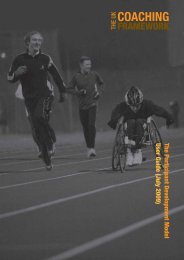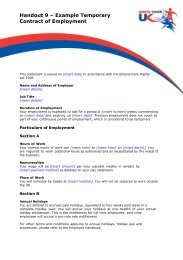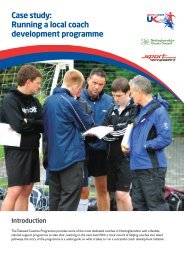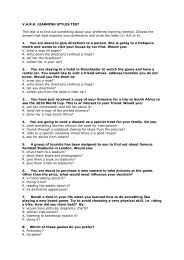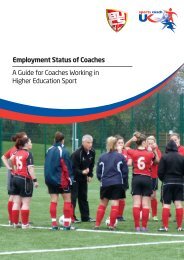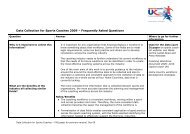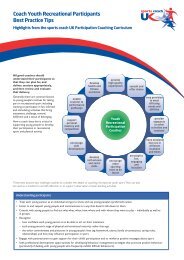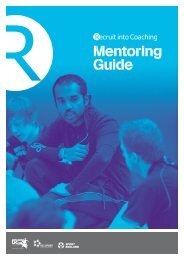Creating a Mentoring Programme for Sport: A ... - sports coach UK
Creating a Mentoring Programme for Sport: A ... - sports coach UK
Creating a Mentoring Programme for Sport: A ... - sports coach UK
Create successful ePaper yourself
Turn your PDF publications into a flip-book with our unique Google optimized e-Paper software.
30<strong>Creating</strong> a <strong>Mentoring</strong> <strong>Programme</strong> <strong>for</strong> <strong>Sport</strong>5Once you have identified the profile of your targetgroup, consider why they may wish to join yourprogramme and what it is that will draw them in –this will become your key marketing tool. Thefollowing process should help get you on the rightpath to attracting the right people:1 Decide what type of person you want.Describe them, perhaps through a shortnarrative (their behaviours and actions) or, ifappropriate, a detailed job description (detailingduties) and person specification (detailingexperiences). The National OccupationalStandards (NOS) <strong>for</strong> Coaching and <strong>Mentoring</strong>are a good starting point. Advertising <strong>for</strong> aspecific role is more likely to attract the rightpeople. Be careful not to say who you don’twant as this will not reflect well on yourprogramme or your organisation.2 Identify what will draw them to yourprogramme. Is it the thought of payment orrecognition as a valued <strong>coach</strong>/practitioner intheir field? Is being associated with yourprogramme a positive career move and seen asincreasing their credibility? Do they simply wishto re-invest in the future of <strong>coach</strong>ing?Understanding their motivations is importantas this will help in tailoring your recruitmentstrategy and provide a clear recruitmentmessage.3 Where can you find potential mentors? It isimportant that you do not simply launch into animmediate recruitment campaign either using ablanket approach (trying to appeal to everyone)or targeting the same sources as be<strong>for</strong>e. It isrecognised that mentoring is a skilled role, andyou will probably need to go beyond yourtraditional contact database. There<strong>for</strong>e, take timeto consider who the appropriate people couldbe. What sort of groups do they come from(business, community groups, voluntary sector,retired work<strong>for</strong>ce, eg teachers)? Are theyexisting <strong>coach</strong>es within clubs?Note: Ensure you are aiming to meet a truerepresentation of the community with thisprogramme to make sure you have a diversemix of skills, abilities and experiences. This willinevitably make your matching process easierand ensure your mentees get a more roundedexperience. This will enhance the programme’scredibility and improve your ability to focus onthe needs of your target group.4 How can you reach them? Once you have abetter idea regarding who your potentialmentors are and where they may reside, youcan be much more focused in the method youuse to reach them. A variety of methods willencourage diversity in applicants, hopefullyreflecting the social composition of thecommunity within which your programme willoperate. Promotional methods include:– leaflets and flyers (targeted drops)– advertisements in local media (magazines,newspapers etc)– use of websites (CoachWeb, governing bodyof sport, CSP etc)– direct contact with local, regional andnational companies– press releases (in a variety of media, includingeBulletins)– recruitment fairs or similar events– open events/inviting those recommended togroup sessions– utilising links with higher education(HE)/further education (FE) institutions asthey often have motivated volunteers– visiting local <strong>sports</strong> clubs, activity groupsand associations.Use any past experience you have. Contact past orexisting mentors and mentees as they will know thesystems and should be good advocates <strong>for</strong> your newprogramme. Finally, word of mouth is the mostcommonly used method of recruitment. Make sureeveryone you know is aware of the programme andthe type of person you are looking <strong>for</strong>, and that theytell other people!Keep the in<strong>for</strong>mation you provide simple. Avoid theuse of jargon and abbreviations where possible.These can be quite off-putting to the reader and arenot accessible to everyone. As a general rule, yourpublicity material should include the following:• the purpose of this mentoring programme andhow it will operate• the length of the programme• mentors’ commitment in terms of timeand activities• the training and ongoing support offered• the key phases of a mentoring programme• what they need to do to get involved• who the main point of contact is.Remember – advertise in places the ideal candidatewould go!Application processYou may wish to use a <strong>for</strong>mal application <strong>for</strong>m or asimple expression of interest. Whichever it is, be sureyou gather the details you need to make anin<strong>for</strong>med decision regarding their suitability. Try to




